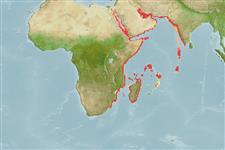>
Eupercaria/misc (Various families in series Eupercaria) >
Lutjanidae (Snappers) > Lutjaninae
Etymology: Lutjanus: Malay, ikan lutjan, name of a fish.
More on author: Cuvier.
Environment: milieu / climate zone / depth range / distribution range
Écologie
marin récifal; profondeur 9 - 150 m (Ref. 9710). Tropical; 31°N - 30°S, 30°E - 77°E (Ref. 55)
Western Indian Ocean: Red Sea east to the Arabian Sea and south to Natal, South Africa. Records of this species from the eastern Indian Ocean and the Western Central Pacific are probably misidentifications of Lutjanus malabaricus (Ref. 55). Has been misidentified as Lutjanus coccineus by recent authors.
Length at first maturity / Taille / Poids / Âge
Maturity: Lm 51.1, range 50 - 60 cm
Max length : 100.0 cm TL mâle / non sexé; (Ref. 9710); common length : 70.0 cm TL mâle / non sexé; (Ref. 5450); poids max. publié: 23.0 kg (Ref. 469); âge max. reporté: 13 années (Ref. 1488)
Épines dorsales (Total) : 10; Rayons mous dorsaux (Total) : 13 - 14; Épines anales: 3; Rayons mous anaux: 8 - 9. Dorsal profile of head angular, snout steeply sloped. Preorbital bone broad, with horizontal grooves behind and below the eye. Anterior and posterior nostrils widely spaced. Preopercular notch and knob poorly developed. Scale rows on back rising obliquely above lateral line. Juveniles with a broad brown bar from upper jaw to beginning of dorsal fin and a series of reddish horizontal lines on sides.
Adults inhabit coral and rocky reefs to depths of at least 100 m (Ref. 30573). Off South Africa they display a preference for slightly silty, turbid regions in the vicinity of sometimes shallow, offshore banks. Captured mainly at night on coral banks off Mafia Island (Tanzania) in 9 to 12 m and off Zanzibar in about 75 m. They are active at night feeding over sandy or rubble bottoms (Ref. 9710). Maximum depth reported taken from Ref. 9773.
Allen, G.R., 1985. FAO Species Catalogue. Vol. 6. Snappers of the world. An annotated and illustrated catalogue of lutjanid species known to date. FAO Fish. Synop. 125(6):208 p. Rome: FAO. (Ref. 55)
Statut dans la liste rouge de l'IUCN (Ref. 130435)
Menace pour l'homme
Harmless
Utilisations par l'homme
Pêcheries: hautement commercial; pêche sportive: oui; Aquarium: Commercial
Outils
Articles particuliers
Télécharger en XML
Sources Internet
Estimates based on models
Preferred temperature (Ref.
123201): 23.4 - 29.2, mean 26.8 °C (based on 328 cells).
Phylogenetic diversity index (Ref.
82804): PD
50 = 0.5000 [Uniqueness, from 0.5 = low to 2.0 = high].
Bayesian length-weight: a=0.01445 (0.00822 - 0.02541), b=2.96 (2.82 - 3.10), in cm total length, based on LWR estimates for this species & Genus-body shape (Ref.
93245).
Niveau trophique (Ref.
69278): 4.5 ±0.7 se; based on diet studies.
Résilience (Ref.
120179): Faible, temps minimum de doublement de population : 4,5 à 14 années (K=0.24; tm=2.5-6; tmax=13).
Fishing Vulnerability (Ref.
59153): Moderate vulnerability (39 of 100).
Nutrients (Ref.
124155): Calcium = 20.1 [12.1, 30.3] mg/100g; Iron = 0.298 [0.190, 0.484] mg/100g; Protein = 18.6 [17.1, 19.9] %; Omega3 = 0.126 [0.086, 0.186] g/100g; Selenium = 74.5 [44.1, 119.9] μg/100g; VitaminA = 173 [33, 695] μg/100g; Zinc = 0.311 [0.241, 0.432] mg/100g (wet weight);
